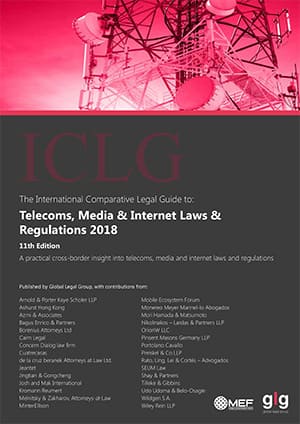There are three major operators in Taiwan’s telecoms market: Chunghwa Telecom; Taiwan Mobile; and FarEasTone Telecom. These three operators provide integrated telecoms services comprising fixed-line, mobile and broadband networks, and the market shares are over 70% of total telecoms services. Currently telecoms services are liberalised, except the mobile/wireless telecoms services, which have to be allocated available frequency. In general, foreign investment is only capped by certain restrictions on Type I telecoms business and no further restrictions on Type II telecoms business apply.
In the market of terrestrial television, in addition to the public broadcasting group (so-called Taiwan Broadcasting System, including CTS and PTS), there are three other stations (TTV, CTV and FTV). In the cable TV market, there are 62 system operators and three programme transmission systems, and most of the system operators belong to the five major multi-system operators (Kbro, CNS, TBC, TFN and TOP), acquiring 90% of the market share. There are a few direct broadcasting satellite operators, but they cannot compete at all with the cable market. In the programme channel market there have been more than 300 landing licences issued as of 30 June 2017. Foreign investment, either direct or indirect, is subject to legal restrictions on cable and channel providers.
The major modes of internet access service are ADSL, FTTx and cable modem. Chunghwa Telecom is the largest provider of ADSL/ FTTx and acquires about 70% of the market share; the leading cable modem operators are Kbro and CNS, acquiring about 20% of the market share. In the mobile market, an official statistic suggests that as of 30 June 2017, 3G and 4G services have a total of more than 30 million users. 4G LTE licences for mobile broadband services in the frequency bands of 700MHz, 900MHz and 1800MHz are available. Five operators – Chunghwa Telecom, Taiwan Mobile, FarEasTone, Asia Pacific Telecom, and Taiwan Star – have put the 4G market in fierce price competition since 2015. There were 20 million subscribers to the LTE-Advance service until the end of June 2017. The monthly data transmission for a 4G user amounts to 9.3GB on average. This is all thanks to the National Communications Commission’s aggressive number portability policy and the “allyou-can-eat” fee plan heavily marketed by the operators.
The Fundamental Communications Act was created in January 2004 to address the goals to be achieved in the course of digital convergence. Functionally, there is the Telecommunications Act, the Radio and Television Law, the Cable Radio and Television Law, and the Satellite Broadcasting Law respectively, which draw lines in between respective transmission platforms, though the National Communications Commission (NCC) has been exercising its exclusive power granted by the Fundamental Communications Act to have regulatory reform by converging all of the above platform regulations into a single legislation. There is no specific regulation for the internet. It is noted, however, that the internet, in relation to audiovisual content distribution, remains a grey area in NCC’s policy.


